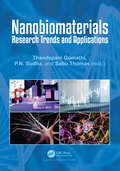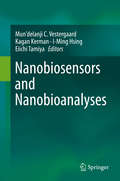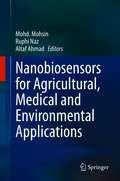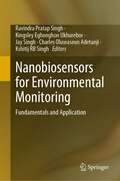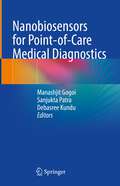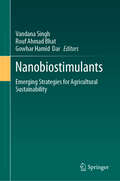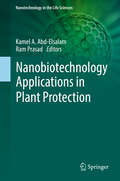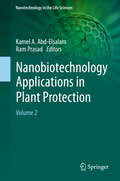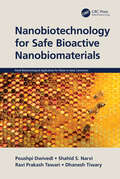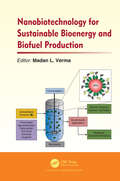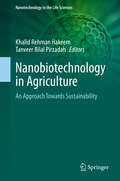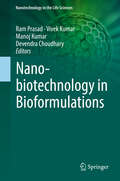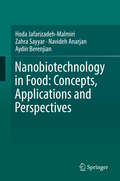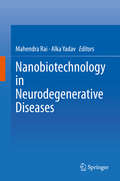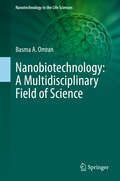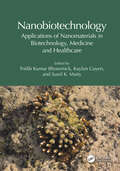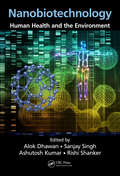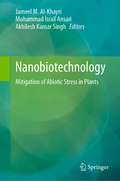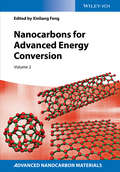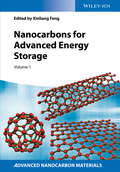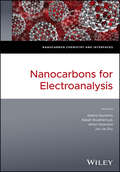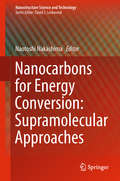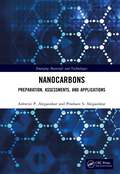- Table View
- List View
Nanobiomaterials: Research Trends and Applications
by Sabu Thomas P. N. Sudha Thandapani GomathiNanobiomaterials: Research Trends and Applications – Biomaterials are derived from natural resources such as plants, animals and marine sources. These biomaterials have advanced applications, across a range of key industries due to their low cost, being easy to process, being biocompatible and so on. The modification of biomaterials in the nanoform enhances their applications. The book begins with an overview of nanobiomaterials, processing, classifications, fabrication and sustainability. In-depth chapters in Part I address the most recent methods and techniques for physicochemical characterisation, processing of blends and composites based on nanomaterials, and separation. Chapters in Part II focus on the biological and biomedical applications specifically in antimicrobial chemotherapy, drug delivery, tissue engineering, cancer therapeutics, robust biosolar cells, and 3D printing. The chapters in Part III mostly focus on environmental applications, including wastewater treatment, water desalination, bioremediation, and agricultural uses. The book is extremely useful for scientists, R&D specialists, designers, and engineers across sectors and disciplines who are interested in using biopolymers for parts and products.
Nanobiosensors and Nanobioanalyses
by Mun'Delanji C. Vestergaard Kagan Kerman I-Ming Hsing Eiichi TamiyaThis book provides a comprehensive review of established, cutting-edge, and future trends in the exponentially growing field of nanomaterials and their applications in biosensors and bioanalyses. Part I focuses on the key principles and transduction approaches, reviewing the timeline featuring the important historical milestones in the development and application of nanomaterials in biosensors and bioanalyses. Part II reviews various architectures used in nanobiosensing designs focusing on nanowires, one- and two-dimensional nanostructures, and plasmonic nanobiosensors with interferometric reflectance imaging. Commonly used nanomaterials, functionalization of the nanomaterials, and development of nanobioelectronics are discussed in detail in Part III with examples from screen-printed electrodes, nanocarbon films, and semiconductor quantum dots. Part IV reviews the current applications of carbon nanotubes, nanoneedles, plasmonic sensors, electrochemical scanning microscopes, and field-effect transistors with the future outlook for emerging technologies. Attention is also given to potential challenges, in particular, of taking these technologies at the point-of-need. The book concludes by providing a condensed summary of the contents, with emphasis on future directions. Nanomaterials have become an essential part of biosensors and bioanalyses in the detection and monitoring of medical, pharmaceutical, and environmental conditions, from cancer to chemical warfare agents. This book, with its distinguished editors and international team of expert contributors, will be an essential guide for all those involved in the research, design, development, and application of nanomaterials in biosensors and bioanalyses.
Nanobiosensors for Agricultural, Medical and Environmental Applications
by Altaf Ahmad Mohd. Mohsin Ruphi NazThis informative book compiles the most up-to-date applications of nanobiosensors in fields ranging from agriculture to medicine. The introductory section describes different types of nanobiosensors and use of nanobiosensors towards a sustainable environment. The applications are divided into four broad sections for easy reading and understanding. The book discusses how manipulation, control and integration of atoms and molecules are used to form materials, structures, devices and systems in nano-scale. Chapters in the book shed light on the use of nanosensors in diagnostics and medical devices. Application in food processing as well as in cell signaling is also described. Nanobiosensors have immense use, and this book captures the most important ones.
Nanobiosensors for Environmental Monitoring: Fundamentals and Application
by Charles Oluwaseun Adetunji Ravindra Pratap Singh Kshitij Rb Singh Kingsley Eghonghon Ukhurebor Jay SinghThis book entails detailed information on the utilization of nanobiosensor as an effective technology for the effective detection, monitoring, and management of environmental contaminations to ensure its sustainability and humanity's well-being. The higher level of anthropogenic action has been identified as a threat to humankind's existence due to the higher level of xenobiotic and toxic substances that could interrupt the normal ecosystem. This has prompted numerous agencies both locally and internationally that could play a significant role in environmental pollution mitigation. The application of nanobiosensor has been identified as a sustainable technique that could be applied to ensure proper detection and identification of several environmental contaminants. Nanomaterial’s possible applications created an innovative domain called nanomaterials based biosensors machinery as one of nanotechnology's ultimate sub-divisions. The application of nanomaterials based biosensors machinery and their advancements could be applied globally to resolve numerous environmental sectors' challenges to guarantee the environment's quality and safety. The book will be an excellent collection of reviews based on contemporary research and developments on nanomaterials utilization and applications in environmental monitoring along with their prospects. The book will attempt to give a comprehensive idea of nanomaterial concepts for nanobiosensors applications in an environmental context to help students, researchers, and professionals/practitioners recognize nanomaterials' significance in the environmental domain. The book will also help understand and address the environmental sectors' complications via nanomaterials' utilization and applications. Hence, this book will serve as a textbook and will help students, professionals/practitioners, scientists, researchers, and academicians in various research domains.
Nanobiosensors for point-of-care medical diagnostics
by Manashjit Gogoi Sanjukta Patra Debasree KunduThis book examines the role of nanobiosensors in point-of-care applications for personalized healthcare and management. It begins by discussing various biomaterials that are used for the development of biosensors in medical diagnostics, and reviews advances in their fabrication and the miniaturization of biosensor devices for lab-on-chip analysis. In turn, it explores the rapidly evolving applications of nanomaterials in the context of biomaterial diagnostics. The book also explores the immense potential of biosensors in medical diagnostics, where they are increasingly being used to detect a wide range of biomolecules and biomarkers. In closing, it discusses the current challenges and outlines the future role of nanobiosensors in the development of next-generation point-of-care applications.
Nanobiostimulants: Emerging Strategies for Agricultural Sustainability
by Vandana Singh Rouf Ahmad Bhat Gowhar Hamid DarThe book describes how nanobiostimulants, which are nanoscale materials that can enhance plant growth and productivity, have the potential to revolutionize sustainable agriculture practices. The book covers a wide range of topics, including the properties and functions of nanobiostimulants, the mechanisms behind their effects on plant growth, and the potential risks associated with their use. It also discusses how nanobiostimulants can be used to improve soil health and nutrient uptake, enhance plant resistance to environmental stresses, and increase crop yields. Overall, the book provides a comprehensive overview of the emerging field of nanobiostimulants and its potential applications in sustainable agriculture. It will be of interest to researchers, students, and professionals in the fields of agriculture, nanotechnology, and environmental science.
Nanobiotechnology Applications in Plant Protection (Nanotechnology in the Life Sciences)
by Ram Prasad Kamel A. Abd-ElsalamNanotechnology can target specific agricultural problems related to plant pathology and provide new techniques for crop disease control. Plant breeders and phytopathologists are needed who can apply nanogenomics and develop nanodiagnostic technologies to accurately advance the improvement process and take advantage of the potential of genomics. This book serves as a thorough guide for researchers working with nanotechnology to address plant protection problems.Novel nanobiotechnology methods describe new plant gene transfer tools that improve crop resistance against plant diseases and increase food security. Also, quantum dots (QDs) have emerged as essential tools for fast and accurate detection of particular biological markers. Biosensors, QDs, nanostructured platforms, nanoimaging, and nanopore DNA sequencing tools have the potential to raise sensitivity, specificity, and speed in pathogen detection, thereby facilitating high-throughput analysis and providing high-quality monitoring and crop protection. Also, this book deals with the application of nanotechnology for quicker, more cost-effective, and precise diagnostic procedures of plant diseases and mycotoxins. Applications of nanotechnology in plant pests and disease control, antimicrobial mechanisms, pesticides remediation and nanotoxicity on plant ecosystem and soil microbial communities are discussed in detail. Moreover, the application of specific nanomaterials including silver, copper, carbon- or polymer-based nanomaterials and nanoemulsions are also discussed. Crops treated with safe nanofertilizers and nanopesticides will gain added value because they are free of chemical residues, decay and putative pathogens for human health, sustaining the global demand for high product quality.
Nanobiotechnology Applications in Plant Protection: Volume 2 (Nanotechnology in the Life Sciences)
by Ram Prasad Kamel A. Abd-ElsalamNanobiotechnology Applications in Plant Protection: Volume 2 continues the important and timely discussion of nanotechnology applications in plant protection and pathology, filling a gap in the literature for nano applications in crop protection. Nanobiopesticides and nanobioformulations are examined in detail and presented as powerful alternatives for eco-friendly management of plant pathogens and nematodes. Leading scholars discuss the applications of nanobiomaterials as antimicrobials, plant growth enhancers and plant nutrition management, as well as nanodiagnostic tools in phytopathology and magnetic and supramagnetic nanostructure applications for plant protection. This second volume includes exciting new content on the roles of biologically synthesized nanoparticles in seed germination and zinc-based nanostructures in protecting against toxigenic fungi. Also included is new research in phytotoxicity, nano-scale fertilizers and nanomaterial applications in nematology and discussions on Botyris grey mold and nanobiocontrol. This book also explores the potential effects on the environment, ecosystems and consumers and addresses the implications of intellectual property for nanobiopesticides. Further discussed are nanotoxicity effects on the plant ecosystem and nano-applications for the detection, degradation and removal of pesticides.
Nanobiotechnology for Green Environment
by Amit Kumar Chhotu RamThe book examines environmental issues and their solutions with advancements in biotechnology and nanotechnology. This book will focus on environmental friendly waste management, wastewater treatment, and utilization of wastes for energy. As humanity is struggling for clean air, water and even contaminant free food, our society must ponder the condition of environment. This book covers a variety of environmental issues and how they could be solved through innovations in science, engineering and technology. The authors examine the use of biotechnological methods to remediate wastewater, toxic organic compounds and sludge management problems. The topics include different research disciplines such as water and wastewater treatment, solid waste management and utilization of wastes for energy. This book will be useful for researchers, students, scientists and academicians who are working in multidisciplinary areas like microbiology, biotechnology, nanotechnology to address environmental issues such as water and wastewater treatment, solid waste management and energy resources. Nanobiotechnology for Green Environment covers a variety of environmental issues and how they could be solved through innovations in science, engineering and technology.
Nanobiotechnology for Safe Bioactive Nanobiomaterials (Novel Biotechnological Applications for Waste to Value Conversion)
by Dhanesh Tiwary Poushpi Dwivedi Shahid S. Narvi Ravi Prakash TewariThis book begins with an introduction of nanobiotechnology, followed by biosyntheses of AgNPs, development of silver/chitosan (Ag/CS) polymer nanocomposites, synthesis of silver/chitosan-g-poly acrylamide (Ag/CS-g-PAAm) nanocomposite hydrogel and silver/chitosan/poly vinyl chloride (Ag/CS/PVC) blend. Finally, it presents novel bioengineering of polyfunctional metallic nanostructures other than Ag, emphasizing biomass utilization and value-added conversion over an extended span, including life cycle assessment of the synthesized nanostructures. Features: Includes prospective cost effective, eco-friendly, and safe nanomaterials, synthesized through facile paths Covers the synergistic effect of phytochemicals and nano-Ag antimicrobial agents from an antiviral perspective Includes surface coating systems and super absorbent materials for biomedical purposes Examines nanobiotechnological applications for generating nanoalloys with synchronized nanostructural arrangement of alkaline earth metals and nanoscale dots of transition metals Explores the life cycle assessment of synthesized nanomaterials This book aims at researchers and graduate students in biomaterials, chemical engineering, green chemistry, nanomaterials, and biotechnology.
Nanobiotechnology for Sustainable Bioenergy and Biofuel Production
by Madan L. VermaNanobiotechnology for Sustainable Bioenergy and Biofuel Production provides insights into the most recent innovations, trends, concerns and challenges in the production of biofuels. This book highlights a number of key research topics and practical applications of modern nanomaterials and nanocomposite-driven enzyme biotechnology for biofuels production, including the advances in the nanoscaffolds design (nanomaterials support) for immobilizing bioenergy producing enzymes (nanobiocatalyst system), the recent trends in biomass processing (untreated/treated agriculture and food waste, grasses, algal, etc.) using advanced nanobiocatalysts for biofuels production and the scale-up study of bioenergy production using nanomaterials immobilized enzymes and biofuel harvesting using nanomaterials. At the outset of new nanobiotechnology applications in biofuel production, there is a need for a new resource in the bioenergy field. This book delivers an overview of the contributions of biofuel production and the most up-to-date advances in nanobiotechnology to a diverse audience ranging from post-graduate students to researchers in biochemical engineering, biotechnology, bioremediation and environmental studies and pharmaceutical professionals. Key Features • Outlines the most recent nanobiotechnological advances in biofuels and bioenergy for biofuels productions • Covers biodiesel, bioethanol, biomethane, biohydrogen, biorefineries and biofuel harvesting using nanomaterials • Explains the scale-up nanobiotechnological study of biofuel production at the bioreactor level
Nanobiotechnology for Sustainable Food Management
by Amber R. Solangi Fabio Granados-Chinchilla López-Maldonado, Eduardo AlbertoAmong the most novel and ever-growing approaches to improving the food industry is nanobiotechnology. In this book, the prospective role of nanobiotechnology in food which includes quality control and safety through nanosensors and biosensors, targeted delivery of nutrients, controlled release of nutrients, proteins, antioxidants, and flavors through encapsulation and enzymatic reactions for food fortification of fat-soluble compounds is discussed. Along the chapters of this book, nanobiotechnological techniques are addressed in detail with specific emphasis on food science applications.Features: Discusses nanobiotechnology in food for quality control and safety Covers food processing and packaging for food safety Explores the positive role of nanomaterials towards the sustainability of food Provides efficient, real, and sustainable solutions to pertinent global problems Includes case studies and research directions of the nanobiotechnology This book is aimed at researchers and graduate students in nanotechnology and food engineering.
Nanobiotechnology in Agriculture: An Approach Towards Sustainability (Nanotechnology in the Life Sciences)
by Khalid Rehman Hakeem Tanveer Bilal PirzadahAgriculture is considered as a backbone of developing nations as it caters the needs of the people, directly or indirectly. The global agriculture currently faces enormous challenges like land degradation and reduced soil fertility, shrinking of land, low production yield, water accessibility and a dearth of labor due to evacuation of individuals from farming. Besides, the global population increases at an exponential rate and it is predicted that the global population will be 9 billion by 2050 that in turn leads to food crisis in near future. Although, green revolution revolutionizes the agriculture sector by enhancing the yield but it was not considered as a sustainable approach. Exorbitant use of chemical fertilizers and pesticides to boost the crop yield is definitely not a convenient approach for agriculture sustainability in the light of the fact that these chemical fertilizers are considered as double-edged sword, which on one hand enhance the crop yield but at the same time possess deleterious effect on the soil microflora and thus declines its fertility. Besides, it cause irreversible damage to the soil texture and disrupts the equilibrium in the food chain across ecosystem, which might in turn lead to genetic mutations in future generations of consumers. Thus, the increased dependence on fabricated agricultural additives during and post green revolution has generated serious issues pertaining to sustainability, environmental impact and health hazards. Therefore, nano-biotechnology has emerged as a promising tool to tackle the above problems especially in the agriculture sector. Nano-agribusiness is an emerged field to enhance crop yield, rejuvenate soil health, provide precision farming and stimulate plant growth. Nano-biotechnology is an essential tool in modern agriculture and is considered as a primary economic driver in near future. It is evaluated that joining of cutting edge nanotechnology in agribusiness would push the worldwide monetary development to approximately US$ 3.4 trillion by 2020 which clearly indicates that how agri-nanobiotechnology plays a pivotal role in the agricultural sector, without any negative impact on the environment and other regulatory issues of biosafety. Agri-nanobiotechnology is an innovative green technology, which provides the solution to global food security, sustainability and climate change. The current book is presenting the role of nano-biotechnology in modern agriculture and how it plays a pivotal role to boost the agri-business.
Nanobiotechnology in Bioformulations (Nanotechnology in the Life Sciences)
by Manoj Kumar Ram Prasad Vivek Kumar Devendra ChoudharyWith the recent shift of chemical fertilizers and pesticides to organic agriculture, the employment of microbes that perform significant beneficial functions for plants has been highlighted. This book presents timely discussion and coverage on the use of microbial formulations, which range from powdered or charcoal-based to solution and secondary metabolite-based bioformulations. Bioformulation development of biofertilizers and biopesticides coupled with the advantages of nanobiotechnology propose significant applications in the agricultural section including nanobiosensors, nanoherbicides, and smart transport systems for the regulated release of agrochemical. Moreover, the formulation of secondary metabolites against individual phytopathogens could be used irrespective of geographical positions with higher disease incidences. The prospective advantages and uses of nanobiotechnology generate tremendous interest, as it could augment production of agricultural produce while being cost-effective both energetically and economically. This bioformulation approach is incomparable to existing technology, as the bioformulation would explicitly target the particular pathogen without harming the natural microbiome of the ecosystem.Nanobiotechnology in Bioformulations covers the constraints associated with large-scale development and commercialization of bioinoculant formations. Furthermore, exclusive emphasis is be placed on next-generation efficient bioinoculants having secondary metabolite formulations with longer shelf life and advanced competence against several phytopathogens. Valuable chapters deal with bioformulation strategies that use divergent groups of the microbiome and include detailed diagrammatic and pictorial representation. This book will be highly beneficial for both experts and novices in the fields of microbial bioformulation, nanotechnology, and nano-microbiotechnology. It discusses the prevailing status and applications available for microbial researchers and scientists, agronomists, students, environmentalists, agriculturists, and agribusiness professionals, as well as to anyone devoted to sustaining the ecosystem.
Nanobiotechnology in Food: Concepts, Applications and Perspectives
by Hoda Jafarizadeh-Malmiri Zahra Sayyar Navideh Anarjan Aydin BerenjianThis text focuses on the many benefits of the use of nanobiotechnology in the food industry. Each aspect of nanobiotechnology use is covered in depth, from food processing to packaging to safety and quality control. The authors outline the definition and history of nanobiotechnology and cover novel technologies for its use in the food industry, including the advantages and challenges for food scientists. Individual chapters focus on the food industry's use of nano-additives, nano-sensors, nano-encapsulation for nutrition delivery and considerations for commercialization. The potential hazards for nanoparticle use, as well as the future prospects of nanobiotechnology use in the food industry, are presented here in depth. Nanobiotechnology in Food: Concepts, Applications and Perspectives explores the emerging developments in nanotechnology which make it increasingly applicable to the food industry. Nanoparticles are applied during food processing to improve nutritional quality, flow properties, flavor, color and stability, and also to increase shelf life by decreasing the activity of microorganisms. Nanotechnology is important for the development of healthier foods with lower fat, sugar and salt levels, and to overcome many food-related diseases. This book shows how producers and manufacturers can make great strides in food quality and safety by using nanotechnology.
Nanobiotechnology in Neurodegenerative Diseases
by Mahendra Rai Alka YadavThis book focuses on neurodegenerative diseases which have become a major threat to human health. Neurodegenerative diseases are age related disorders and have become increasingly prevalent in the elderly population in recent years. Hence, there is an urgent need to study and develop new strategies and alternative methods for the treatment of neurodegenerative diseases. This book showcases the promises that nanobiotechnology brings in research, diagnosis, and treatment of neurodegenerative diseases. It is very beneficial for varied group of readers including nanotechnologists, biotechnologists, pharmacists, medical professionals, bioengineers, biochemists and researchers working in this field. Nanobiotechnology in Neurodegenerative Diseases include various chapters including neurodegeneration and neurodegenerative diseases, nanotechnology for the rescue of neurodegenerative diseases, promising potential of nanomaterials for diagnosis and therapy of neurodegenerative diseases, nanotechnology mediated nose-to-brain drug delivery, and formulation and characterization of intranasal nanoparticles of antiretroviral drugs.
Nanobiotechnology: A Multidisciplinary Field of Science (Nanotechnology in the Life Sciences)
by Basma A. OmranThe generation of well-defined nanoparticles of excellent size and shape involves physical and chemical methodologies that are complicated, expensive, and produce hazardous toxic waste that is harmful to the environment and to human health. In order to combat the disadvantages of these methods, scientists have created “the biological method,” a new synthetic methodology that serves as a proper alternative to physical and chemical methodologies because of its easy utility, low cost, rapid synthesis, controlled size characteristics, controlled toxicity, and eco-friendliness. Nanobiotechnology is the science in which living matter can be manipulated and exploited to produce materials within the nano-scale. It is a multidisciplinary field of science framed by biology, chemistry, engineering, materials, and life sciences. Different biological entities can be exploited to yield biologically synthesized nanomaterials including bacteria, actinomycetes, yeast, fungi, viruses, algae, plant extracts, and agro-industrial waste extracts. This book represents a comprehensive review concerning the state of the art in nanobiotechnology, emphasizing the use of diverse biological entities in the science, and its versatile applications. It describes currently existing methodology with the latest published references, and provides safety information. It serves as the ideal guide for scientists interested in exploring nanobiotechnology.
Nanobiotechnology: Applications of Nanomaterials in Biotechnology, Medicine and Healthcare
by Kalyan Gayen Tridib Kumar Bhowmick Sunil K. MaityThis book covers topics related to drug delivery, biomaterials, drug design, formulation development, nanoscience, and nanotechnology. It describes the fundamental concepts in nanotechnology and their different applications in biotechnology to solve engineering challenges and generate new areas of technological development. Nanobiotechnology: Applications of Nanomaterials in Biotechnology, Medicine, and Healthcare covers vast application areas that include medical science, material science, pharmaceutical science, and environmental science. Section 1 presents recent research updates on the different nanomaterials, which are promising in different medical and biotechnological applications. Applications of nanomaterials as bone replacement orthopedic implants have revolutionized the treatment of orthopedic surgery. Nanostructured polymeric materials have gained immense research attention as therapeutic carriers for the precise delivery of drugs at targeted sites. Nanocellulose is recognized as a promising green nanomaterial due to its renewability and abundance in nature. Scientific topics on the most recent scientific and technological advances and applications of different nanostructured materials are presented in this section. Section 2 focuses on the novel synthesis methods that are used extensively and are promising for large-scale production of inorganic and nanostructured materials. Section 3 covers the applications of nanotools in the treatment of different diseases, including cancers and genetic diseases. The increasing use of nanotechnology will bring changes in the manufacturing processes of nanomaterials. The applications of nanomaterials in the field of medical imaging and molecular detection are presented in section 4. This book will be useful for students, researchers, scientists, academicians, and industrial manufacturers to understand the importance and applicability of nanomaterials in the field of biotechnology and medical science.
Nanobiotechnology: Human Health and the Environment
by Alok Dhawan, Sanjay Singh, Ashutosh Kumar and Rishi ShankerThis book combines the contributions from the experts of material science, molecular biology, toxicology bio-organic and bio-inorganic chemistry, toxicologists and environmental and food technology etc. to fathom the full scope of current and future of developments in the area of Nanobiotechnology. Provides brief overview of nanobiotechnology for general readers who are not familiar with the research fields and presents a strong overview of most of the critical areas in field This book can also be used as text book for graduate students as an essential reference material, and as an reading material for general readers having a curiosity in Nanobiotechnology.
Nanobiotechnology: Mitigation of Abiotic Stress in Plants
by Jameel M. Al-Khayri Akhilesh Kumar Singh Mohammad Israil AnsariThis book provides up-to-date knowledge of the promising field of Nanobiotechnology with emphasis on the mitigation approaches to combat plant abiotic stress factors, including drought, salinity, waterlog, temperature extremes, mineral nutrients, and heavy metals. These factors adversely affect the growth as well as yield of crop plants worldwide, especially under the global climate change. Nanobiotechnology is viewed to revolutionize crop productivity in future. The chapters discuss the status and prospects of this cutting-edge technology toward understanding tolerance mechanisms, including signaling molecules and enzymes regulation in addition to the applications of Nanobiotechnology to combat individual abiotic stress factors.
Nanocarbons for Advanced Energy Conversion
by Xinliang FengIn this second volume in the first book series on nanocarbons for advanced applications the highly renowned series and volume editor has put together a top author team of internationally acclaimed experts on carbon materials. Divided into three major parts, this reference provides a current overview of the design, synthesis, and characterization of nanocarbons, such as carbon nanotubes, fullerenes, graphenes, and porous carbons for energy conversion applications. It covers such varied topics as electrocatalysts for oxygen reduction reactions in the different types of fuel cells, metal-air batteries and electrode materials for photovoltaic devices, as well as photocatalysts, electrocatalysts and photoelectrocatalysts for water splitting. Throughout, the authors highlight the unique aspects of nanocarbon materials in these fields, with a particular focus on the physico-chemical properties which lead to enhanced device performances.
Nanocarbons for Advanced Energy Storage, Volume 1
by Xinliang FengThis first volume in the series on nanocarbons for advanced applications presents the latest achievements in the design, synthesis, characterization, and applications of these materials for electrochemical energy storage. The highly renowned series and volume editor, Xinliang Feng, has put together an internationally acclaimed expert team who covers nanocarbons such as carbon nanotubes, fullerenes, graphenes, and porous carbons. The first two parts focus on nanocarbon-based anode and cathode materials for lithium ion batteries, while the third part deals with carbon material-based supercapacitors with various applications in power electronics, automotive engineering and as energy storage elements in portable electric devices. This book will be indispensable for materials scientists, electrochemists, physical chemists, solid state physicists, and those working in the electrotechnical industry.
Nanocarbons for Electroanalysis (Nanocarbon Chemistry and Interfaces)
by Rabah Boukherroub Jun-Jie Zhu Nianjun Yang Sabine Szunerits Alison DownardA comprehensive look at the most widely employed carbon-based electrode materials and the numerous electroanalytical applications associated with them. A valuable reference for the emerging age of carbon-based electronics and electrochemistry, this book discusses diverse applications for nanocarbon materials in electrochemical sensing. It highlights the advantages and disadvantages of the different nanocarbon materials currently used for electroanalysis, covering the electrochemical sensing of small-sized molecules, such as metal ions and endocrine disrupting chemicals (EDCs), as well as large biomolecules such as DNA, RNA, enzymes and proteins. A comprehensive look at state-of-the-art applications for nanocarbon materials in electrochemical sensors Emphasizes the relationship between the carbon structures and surface chemistry, and electrochemical performance Covers a wide array of carbon nanomaterials, including nanocarbon films, carbon nanofibers, graphene, diamond nanostructures, and carbon-dots Edited by internationally renowned experts in the field with contributions from researchers at the cutting edge of nanocarbon electroanalysis Nanocarbons for Electroanalysis is a valuable working resource for all chemists and materials scientists working on carbon based-nanomaterials and electrochemical sensors. It also belongs on the reference shelves of academic researchers and industrial scientists in the fields of nanochemistry and nanomaterials, materials chemistry, material science, electrochemistry, analytical chemistry, physical chemistry, and biochemistry.
Nanocarbons for Energy Conversion: Supramolecular Approaches (Nanostructure Science and Technology)
by Naotoshi NakashimaThis book focuses on nanocarbons (carbon nanotubes, graphene, nanoporous carbon, and carbon black) and related materials for energy conversion, including fuel cells (predominately proton exchange membrane fuel cells [PEMFC]), Li-ion batteries, and supercapacitors. Written by a group of internationally recognized researchers, it offers an in-depth review of the structure, properties, and functions of nanocarbons, and summarizes recent advances in the design, fabrication and characterization of nanocarbon-based catalysts for energy applications. As such, it is an invaluable resource for graduate students, academics and industrial scientists interested in the areas of nanocarbons, energy materials for fuel cells, batteries and supercapacitors as well as materials design, and supramolecular science.
Nanocarbons: Preparation, Assessments, and Applications (Emerging Materials and Technologies)
by Ashwini P. Alegaonkar Prashant S. AlegaonkarThis book provides a practical platform to the readers for facile preparation of various forms of carbon in its nano-format, investigates their structure–property relationship, and finally, realizes them for a variety of applications taking the route of application engineering. It covers the preparation and evaluation of nanocarbons, variety of carbon nanotubes, graphene, graphite, additively manufactured 3D carbon fibres, their properties, and various factors associated with them. A summary and outlook of the nanocarbon field is included in the appendices. Features: Presents comprehensive information on nanocarbon synthesis and properties and some specific applications Covers the growth of carbon nanoparticles, nanotubes, ribbons, graphene, graphene derivatives, porous/spongy phases, graphite, and 3D carbon fabrics Documents a large variety of characterizations and evaluations on the nature of growth causing effect on structure properties Contains dedicated chapters on miniaturized, flat, and 2D devices Discusses a variety of applications from military to public domains, including prevalent topics related to carbon. This book is aimed at researchers and graduate students in materials science and materials engineering, and physics.
